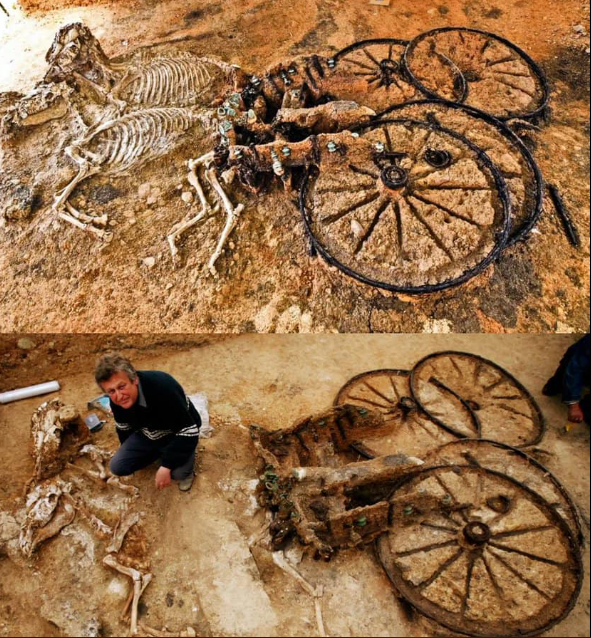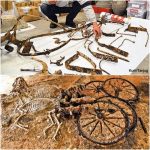Ancient civilizations have a way of captivating our collective imagination, and when a remarkable archaeological discovery surfaces, it’s no wonder it piques our curiosity. Such is the case with the 2,000-year-old Thracian chariot that was recently unearthed in the village of Karanovo, Bulgaria.
A Glimpse into Thracian Aristocracy
In November 2008, a team of archaeologists led by Veselin Ignatov, of the Istoricheski muzej Nova Zagora, a museum in Bulgaria, made an incredible discovery – a 2,000-year-old wooden chariot, covered in bronze and decorated with scenes from Thracian mythology. This remarkable find offers a fascinating glimpse into the burial practices and beliefs of the ancient Thracian people.
The chariot, which may actually date back around 1,800 years, was found in a tomb of a prominent Thracian aristocrat from the 1st century A.D. It is one of the very few cases where archaeologists can trace the entire pattern of ritual practices accompanying the burials of these ancient elites, who believed in a better afterlife.
The chariot itself is a true marvel of craftsmanship. It has four big wheels, each with a diameter of 4 feet (1.2 meters), and is embellished with richly detailed silver-coated small figures of the god Eros and mythical creatures with panther-like bodies. Alongside the chariot, the archaeologists also discovered the skeletons of two horses and a dog, likely included to provide the deceased with transportation and companionship in the afterlife.
Uncovering Thracian Beliefs and Customs
The discovery of this ancient chariot provides valuable insights into the beliefs and customs of the Thracian people. The practice of burying the deceased with objects they would need in the afterlife was a central part of Thracian funerary rites. The richer and more noble the person, the more elaborate and extravagant the burial gifts.
In addition to the chariot and animal remains, the archaeologists also found a wealth of other artifacts, including table pottery, glass vessels, and well-preserved wooden and leather objects, some of which may have been horse harnesses. All of these items were carefully placed in the funerary mound, to be used by the aristocrat in the next life.
Preserving a Piece of History
The bronze-plated wooden chariot, with its stunning mythological decorations, is a truly remarkable find that sheds light on the rich cultural heritage of the Thracian people. This discovery not only highlights the advanced craftsmanship and beliefs of the ancient Thracians but also serves as a testament to the importance of preserving and studying our shared history.
As we continue to uncover the secrets of the past, stories like this remind us of the fascinating and diverse cultures that have shaped the world we live in today. The 2,000-year-old Thracian chariot is a tangible reminder of the enduring legacy of these ancient people and the power of archaeology to illuminate the human experience across the ages.
The discovery of the 2,000-year-old Thracian chariot in Karanovo, Bulgaria is a remarkable testament to the ingenuity, beliefs, and cultural heritage of the ancient Thracian people. This exquisite artifact, with its intricate decorations and accompanying burial goods, provides a unique window into the lives and afterlife beliefs of the Thracian aristocracy. As we continue to study and preserve these remnants of the past, we are reminded of the rich tapestry of human civilization and the enduring power of archaeological discovery to captivate our imaginations and deepen our understanding of the human experience.



